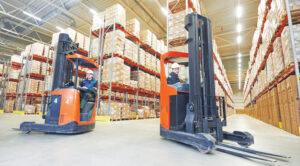Sensors-based autonomous mobile robots are in demand for logistics
March 1, 2023 6:39 pm
MHE, equipped with advanced sensors and controls, provide real-time data on the location and condition of goods, enabling more efficient and effective handling.
Material handling for efficiency in operations and quicker turnarounds
The storage and handling of warehouse materials are being transformed from traditional to modern infrastructure, focusing on productivity, safety, accuracy, consistency, efficiency, and faster turnaround times. Material handling equipment (MHE) has increasingly become automated in recent years, leading to greater efficiency and productivity. Automated guided vehicles (AGVs) can now transport goods without human intervention, reducing the need for manual labour and increasing the speed and accuracy of operations. Energy efficiency and human safety are critical considerations in automated MHE and the payback period.
Advanced sensors and controls are now integrated into MHE, providing real-time data on the location and condition of goods, enabling more efficient and effective handling. For instance, sensors can detect when a product is nearing its expiration date, alerting workers to move quickly and avoid waste. Additionally, sensors are used to sort goods by their date of manufacture.
The sensors from SICK ensure maximum positioning accuracy, repeatability as well as speed, and therefore optimal PSDI times. Its comprehensive portfolio of distance sensors, encoders and vision sensors allow optimal adaptation to the requirements of the respective application.
The consolidation of warehouses reduced land availability, and scarcity of semi-skilled/unskilled labour have all contributed to the development of mechanisation and automation in MHE.
Robotic automation in warehouses and cold storage The adoption of robotics automation in warehouses and cold stores is driven by a focus on productivity, fuel economy, and ease of operation, with safety being the top priority. In automated material handling, robots can complete tasks such as palletising, de-palletising, and goods picking and placing quickly and accurately. This results in faster and more accurate order fulfilment, reducing the need for manual labour, increasing productivity, and minimising the risk of accidents and injuries.
In cold storage operations, robots are particularly useful in facilities with extremely low temperatures, where it is challenging for humans to work efficiently. Robots can perform palletising, de-palletising, and order-picking tasks in these environments, reducing the need for manual labour, improving safety, and minimising the risk of product damage. Sensors play a crucial role in these operations.
Robots can also optimise warehouse space by stacking goods more efficiently and higher, reducing the need for additional storage space and increasing the facility’s overall capacity.
Overall, robotics significantly contributes to the logistics requirements of warehouses and cold storage facilities by improving efficiency, accuracy, and safety while reducing costs and enhancing customer satisfaction.
Innovative technologies to handle logistics and intralogistics needs
The logistics and intralogistics needs of factories are being met by developing new and innovative technologies. Effective combinations of automation technologies are essential for managing warehouse operations, reducing human interaction, and increasing productivity, speed, and accuracy. Examples of technologies that minimise errors and enhance warehouse efficiency are automated machines and picking robots.
Parker products and systems for material handling are helping to improve manufacturing and logistics. Crane solutions provide the highest performance with precise positioning and hoist control. Fork-lift technology provides next generation remote monitoring and precision performance. Augmented Reality (AR) is utilised in factories to reduce errors and increase efficiency by providing workers with real-time information on tasks and procedures. It can also be used to train operators on new equipment or processes, reducing training time and improving safety.
Internet of Things (IoT) sensors is deployed in factories to monitor equipment and products, providing real-time performance, location, and health data. This information can be utilised to optimise logistics and intralogistics operations, reducing downtime and improving efficiency. Blockchain technology is utilised in factories to create secure, transparent, and traceable supply chains. It improves logistics and intralogistics operations by providing real-time information on the movement of goods, minimising the risk of counterfeiting, and improving efficiency.
These new and innovative technologies are developed to meet plants’ logistical and intralogistics requirements, improve efficiency, reduce costs, and enhance safety. As technology advances, further developments can be expected in this area.

Emerging MHE technologies to help automate storage and warehouses
Factories are increasingly adopting Autonomous Mobile Robots (AMRs) because they can handle and transport materials without human intervention. AMRs use sensors, cameras, and mapping technology to navigate factories, making them suitable for logistics and intralogistics needs. These robots can deliver goods throughout the warehouse with impeccable accuracy, using their sophisticated sensor technology to interpret their environment and identify and sort the information in each package. The use of AMRs reduces redundant manual processes that are prone to human error.
Aerial drones are also being used to streamline warehouse inventory processes. They can quickly scan locations for automatic inventory and send the correct count to inventory management software faster than a human can. These drones do not require markers or lasers for guidance and move quickly, making them useful for hard-to-reach places.
Shuttle systems use robotic shuttles to transport goods between storage locations and picking stations, increasing efficiency, reducing labour costs, and increasing storage density.
Such complex systems require high-performance products and technologies to function reliably. As one of the leading manufacturers, SICK Sensors offers mature sensor and software solutions that ensure greater safety, flexibility and efficiency in many areas – throughout the entire value chain Automated material handling technology uses cranes, conveyors, and other automated equipment to store and retrieve goods from high-density storage systems, increasing storage capacity and throughput while eliminating human intervention in the material handling process. This enhances processing accuracy, ensures worker safety, and increases warehouse efficiency.
These automated material handling tools are widely used worldwide in food and beverage processing, e-commerce, retail, and other industries. Robotics systems, conveyor systems, automated storage and retrieval systems, and automated controlled vehicles are just a few examples of the various automated material handling equipment goods that are wellliked globally.Automatically controlled or autonomous vehicles that transport a wide range of products from crates to pallets are becoming increasingly popular in today’s fast-moving environment. Electromechanical actuators lift few tons in a small space for unit load AGV, move the arm of the tow tugs top module or lift the low lift truck AMR. The electromechanical actuators from Ewellix provide efficiency, ease of operation, and positioning with feedback.
Growth of MHE in the industry
Several key indicators can be used to measure growth in the industry’s material handling equipment (MHE) segment. The market size of the MHE sector is increasing by 5 to 7 percent. It can be segmented by product type, including conveyors, forklifts, automated storage and retrieval systems (AS/RS), sensors, etc. MHE market share is also growing in various industries, such as construction (35%), automotive (30%), consumer goods and electronics (13%), mining (12%), and food and beverage (10%), due to the fast Pay Back Period that industry can measure in terms of ROI. MHE manufacturers have adopted innovative trends and technologies, such as IoT, cloud computing, and AI through MECHATRONICS, helping the MHE sector differentiate itself in the market and gain a competitive edge. Energy-saving is also a general industry trend in the MHE sector. Finally, the customer base of MHE products and technologies is gradually increasing by 2 to 5 percent annually, as human safety plays a vital role in market growth.
IoT, AI and RFID driving automated MHE demand
The automated material handling equipment (A-MHE) market is significantly impacted by IoT, AI, and RFID technologies. Here’s how these technologies work in A-MHE operations. IoT is a network of devices connected to the internet that can communicate with each other. In A-MHE, IoT sensors can be embedded in equipment and machines to collect data on their performance and usage, optimising equipment maintenance, reducing downtime, and increasing productivity.
Additionally, IoT sensors can provide real-time tracking of product status and inventory levels, enhancing supply chain management efficiency. AI uses machine learning algorithms to analyse data and make decisions without human intervention. In A-MHE, AI can be used to optimise warehouse layouts, route planning, and inventory management, leading to more efficient and cost-effective operations. RFID technology uses electromagnetic fields to identify and track tags attached to objects. In A-MHE, RFID tags can be used to track the movement and location of products, containers, and equipment in real time, facilitating efficient inventory management and loss prevention. These technologies enhance A-MHE efficiency, productivity, and cost-effectiveness, improving customer satisfaction.
Furthermore, they provide valuable operational insights, enabling businesses to make data-driven decisions that drive continuous improvement. As these technologies advance, we can expect even more sophisticated solutions that further streamline the A-MHE market.
For more information,Visit:www.ngen-group.com
Cookie Consent
We use cookies to personalize your experience. By continuing to visit this website you agree to our Terms & Conditions, Privacy Policy and Cookie Policy.

















 English
English Hindi
Hindi